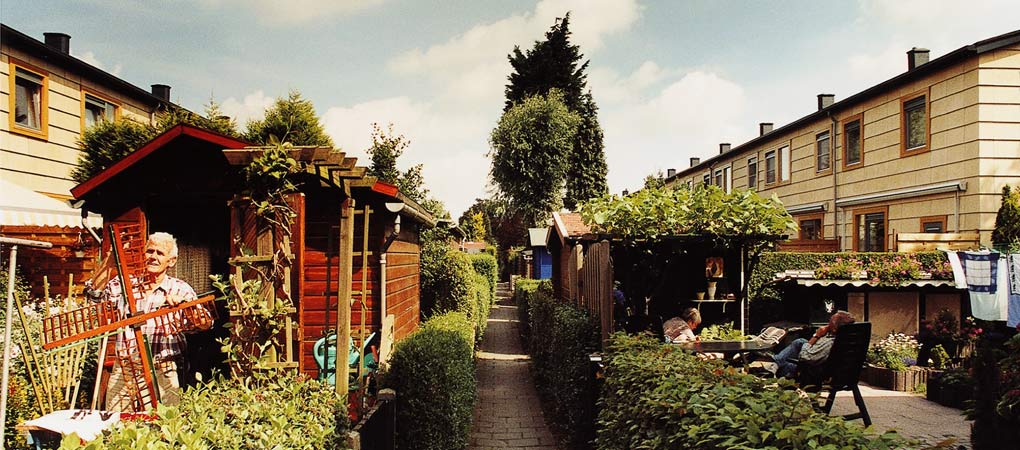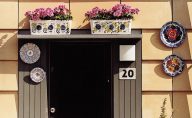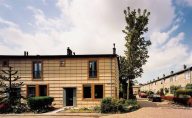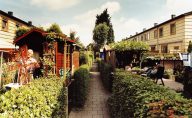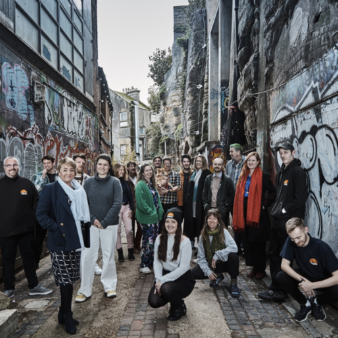This project involves the renovation of Tuindorp Kethel, a post-war garden village of 241 low-cost single-family houses built using pre-fabricated construction systems. Rather than demolishing the deteriorated estate, a sensitive refurbishment process was carried out, improving energy efficiency and addressing the needs of individual properties. Residents were involved throughout the renovation process, from the design stage through to the final construction stage.
Project Description
Aims and Objectives
To renovate a 50-year-old social housing estate built using a prefabricated building system in a manner sympathetic to the wishes and commitment of the residents as well as being financially sustainable for the social housing provider.
Built in the 1950s using the Airey and Welschen pre-fabricated building systems, the 241 houses on this post-war housing estate had deteriorated significantly by the mid 1990s. Water penetration and poor insulation performance were features of the physical deterioration, leading to extensive cold and damp. Tuindorp translates as ‘garden village’ and the estate was originally built as social housing for key local workers.
Although in a poor physical condition there was a strong community, with a long-standing population, many of whom were the original residents. Over the years the residents had made many adaptations to their homes and public spaces, investing much emotional as well as financial capital in their homes and the estate. In 1998 the architects were commissioned by the social housing provider (Woonplus) to ascertain three scenarios for the future of the estate. They identified demolition and rebuild, basic renovation, and more extensive renovation. The preferred option at the time was demolition.

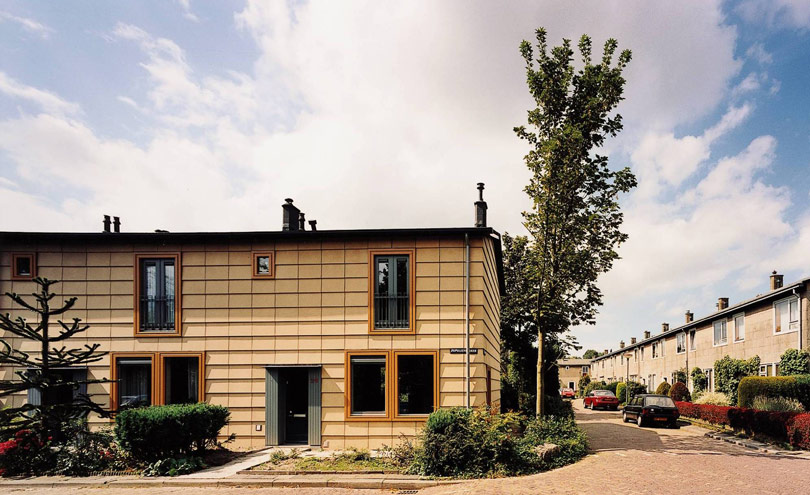
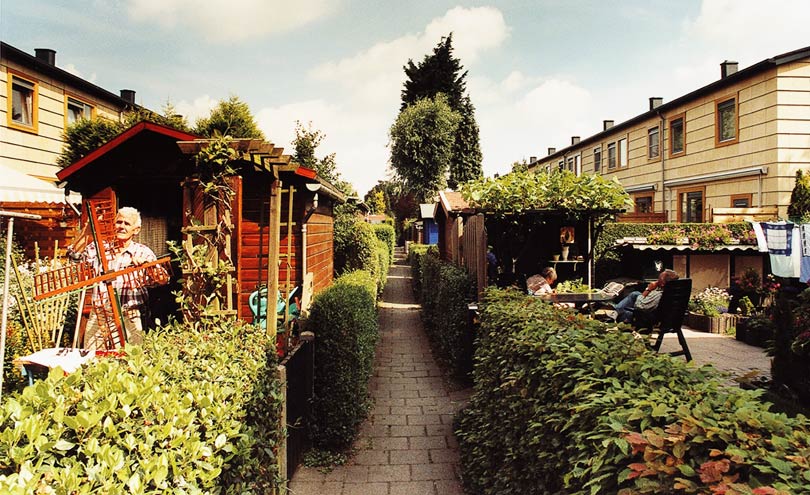
The properties are owned by a social-housing landlord who had initially favoured their demolition. However the architects (BIQ) and the local community convinced the landlord that an affordable refurbishment could be carried out which would preserve the historical value of the estate as well as the strong community that had been established over many years. The refurbishment was carried out by the BIQ architectural practice only after extensive consultation with the residents and primarily dealt with the external refurbishment and insulation work that the residents had been unable to undertake. Five dwellings were refurbished internally with different materials and residents could choose which, if any, of the work they wished to have done inside their own home.
A pre-fabricated fibre-cement cladding system was used in order to maintain continuity with the existing design and also for speed of construction on site. Prior to refurbishment the tenants had decorated their front doors with numbers, lights etc. and the new canopies and large timber surrounds of the new doors are designed to enable this to continue. The residents remained in occupation throughout the refurbishment and careful timetabling / flexibility was needed to ensure minimum disturbance for the residents. The building contractor and architect worked to ensure that phasing and execution of the work would lead to minimal disturbance for the residents.
The completed project cost €11.7 million (US$13.8 million) which is €48,000 (US$57,000) per dwelling. This reflects the typical cost of restoring dwellings of this age and type to a thirty-year life expectancy. Woonplus Housing Association funded the renovation work to its housing stock using its own financial reserves. One third of the funding was raised from the sale of thirty of the houses, which were vacant at the time. This was sufficient to cover the gap in funding. Further properties could have been sold but it was decided to retain as many as possible in social ownership rather than maximise the profit of the organisation. A grant of €550,000 was received from a Dutch utility company to help improve environmental performance.
Like all other Dutch social housing providers Woonplus was given autonomous status in the 1990s with a lump sum to cover future costs of maintenance and management. It therefore carries the responsibility of meeting all ongoing revenue costs from its own income/reserves.
The rents did not increase for the basic renovation package, but a shopping list of extras was provided for tenants which they could choose to have if they wished, but would have to pay for with extra rent (for example, renewal of kitchen would cost an additional €12 (US$14.5) a month at 2001 prices). No recompense is given for any improvements carried out by residents under Dutch housing law.
An extensive resident consultation process was carried out from the outset of the project and continued throughout its development. This included the production and distribution of a regular newsletter. A small school building on the estate was used as a project information centre where residents’ meetings were held.
Five dwellings were refurbished as a demonstration for residents to see the changes being proposed and this led to several design changes being incorporated. Typical issues over which residents were concerned included the windows, positioning of radiators, bathroom and kitchen fittings.
The renovation commenced in 2000 and was completed in 2002.
Why is it innovative?
- Acknowledgement and respect for the emotive value of a dwelling from the tenant’s perspective.
- Resident appropriation and adaptation is viewed as a benefit rather than a problem and is accepted and facilitated.
- Design of the external façade enables residents to continue to personalise their homes.
- Use of a sensitive refurbishment programme which addressed the needs of individual properties rather than using a standard, identical treatment for each property.
- Recognition of the value, in architectural terms, of being involved in the refurbishment of everyday buildings and the opportunities that this presents.
- Current architectural thinking in the Netherlands tends to deny context and the existence of place. BIQ believes that place is highly important and should be built upon, rather than denied and neutralised.
What is the environmental impact?
Refurbishment rather than demolition and new build has avoided the huge expenditure on energy and materials involved in making and transporting building materials, as well as the removal of demolition waste to landfill.
High environmental standards were achieved throughout with increased external insulation, use of new windows and the replacement of boilers with much more efficient ones. Upon completion of the work the environmental standards exceeded those required.
Refurbishment has reduced building traffic and impact on local wildlife and ecology compared to new build project. The Retention of existing layouts maintained limited access for cars.
Is it financially sustainable?
Internal work was only carried out where it was needed. This gave greater economic efficiency by using an individualised, rather than a standardised, refurbishment programme. The cost for the social housing provider was decreased as the investments of the tenants reduced the expenditure on refurbishment.
Residents have been offered the opportunity to purchase their homes at a discount but have not done so due to the large increase in value of the houses on the estate after refurbishment and the relatively low rent, especially for those who have lived there a long time. The costs of owner occupation are twice as high as the rental payments.
Had the demolition and rebuild route been chosen the rents would have increased significantly for the residents. Under the refurbishment scheme the residents continue to pay affordable rents. For those who only wanted the basic refurbishment work carried out these rents did not increase.
What is the social impact?
The existing community at Tuindorp Kethel was very strong and well-established. This project has avoided the threat of demolition that was a very real possibility for the community. The real strength of this project is that the community survives and life continues as normal. The renovation work reinforced the cohesion of the community. A Renovation Task Force was established which consisted of 20 residents who worked as a liaison team between the local community and Woonplus.
Residents were involved throughout the design process, improving their range of skills and experience. The Task Force was considerably professionalised through a capacity-building programme run by a local NGO and ultimately developed into a full member of the design team. It has an on-going relationship with Woonplus.
The strong community that existed before has been retained rather than broken up, which would have happened through a demolition and rebuild process. The resident involvement process was carried out in a very genuine manner and the local community felt empowered through the process.
Improved energy efficiency and the removal of damp and water penetration mean that the residents are warmer and healthier than before.
Barriers
There were few barriers encountered in the project which on balance ran very smoothly, apart from some scheduling and delivery problems which led to some time overruns.
Lessons Learned
The non-adversarial and cooperative building culture in the Netherlands facilitated the construction work at Tuindorp Kethel. This contrasts with the UK for example, where the culture is highly contractual with a prevalent claim culture.
Working with residents is vital, as is attaching value to the improvements they have made to their homes.
There is a pressing need in the Netherlands to address how residents are compensated for investments they have made to their rented property.
Evaluation
Although no specific monitoring has been carried out, the following can be observed:
- The tenants retained their homes and their emotional/physical investments rather than having to see them demolished. The achievement is that life continues as normal.
- Increased comfort and well-being of the residents.
- Preservation of historic housing stock.
- The housing association is able to retain committed tenants.
Transfer
The architectural firm continues to use the approaches and principles established in this project, although has not carried out any further work of a similar nature as yet.
The Woonplus housing association is very proud of the project; it recognises, however, that the approach was used in a very particular situation and may not necessarily be appropriate in all cases.
The project has been accepted as a demonstration project for the Dutch National Trust. The holistic approach used in this project that places residents at the centre of the renovation process has been influential in academic thinking and in some architectural practice.
BIQ is involved in architectural discourse and its integrated thinking and approach as developed in this project are widely known within architectural circles.
Partnership
Central Government, Local Community, Professional

